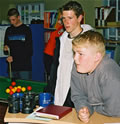About us

"The Charity’s objects are to further the education of under twenty-fives in Stamford"


The Stamford Young People’s Charity is a UK charity established in 1996 to further the education and personal development of young people under the age of 25 who live, or whose parents or guardians, live in Stamford, Lincolnshire.
Objects
The charity’s objects are to further the education of under twenty-fives in Stamford and are defined formally in its trust deed as:
’... advancing the education (including social and physical training) of persons under the age of 25 years who or whose parents are resident in Stamford (the area of benefit) and in particular but without prejudice to the generality of the foregoing in providing special benefits of a kind not normally provided by the local education authority for Church of England schools in the area of benefit.'
Origins and finance
During a reorganisation of secondary school education in Stamford some twenty or so years ago, the Exeter and Fane Schools were combined onto one site in Green Lane, and renamed the Queen Eleanor School (now the Queen Eleanor Technical College).
The money from the sale of the Exeter School site was divided between the Diocese of Lincoln and Lincolnshire County Council, but 30% [J FS1] of it was set aside for charitable educational purposes. This capital sum was given to an already existing charity, previously funded by some of the money raised by the sale of the former St Michael’s School site at the bottom of Recreation Ground Road.
The charity was refounded as The St Michael’s and Exeter Schools’ Charity, known informally as Stamford Young People's Charity, and came into existence on 24th June 1996. Its capital provides an income for charitable uses of between £15.000 and £20,000 per annum.
Trustees
Trustees are drawn from local people with an interest in education and the welfare of young people, and nominated trustees represent Lincolnshire County Council and the Church of England.